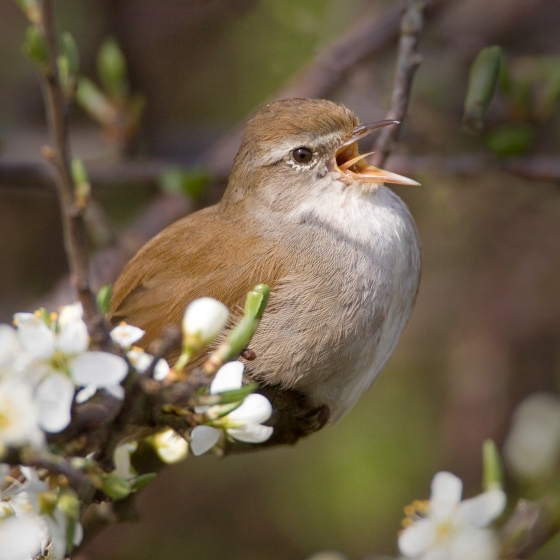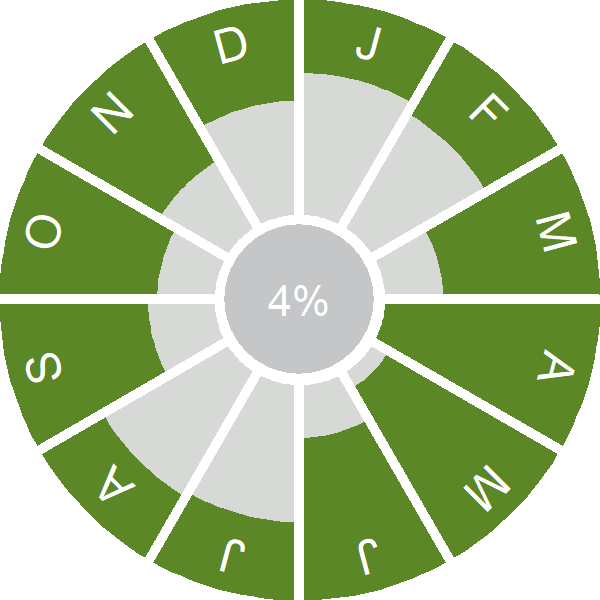Cetti's Warbler
Cettia cetti (Temminck, 1820)
CW
 CETWA
CETWA  12200
12200

Family: Passeriformes > Cettiidae

The loud song of this small brown bird erupts from scrub and reedbeds, announcing a Cetti's Warbler's presence to passersby.
The Cetti's Warbler has undergone range expansion in recent decades. It first bred in Britain in the early-1970s, in Kent. Its range has since moved northwards and it now breeds through to northern England and Wales, although in fairly discrete areas. The winter range is similar. It is likely that the Cetti's Warbler's colonisation of Britain has been facilitated by climatic warming. As the species' range has expanded, its UK population has also risen, although there have been signs of a downturn in recent years. Cetti's Warblers are rare vagrants on the island of Ireland.
Cetti's Warblers inhabitat reedbeds and dense, scrubby vegetation, typically near water. Uniquely among British-breeding birds, Cetti's Warblers have only 10 tail feathers (instead of the usual 12). Females lay bright red eggs, typically in clutches of four or five, and may produce two broods a year. Cetti's Warblers largely eat small insects.
Exploring the trends for Cetti's Warbler
Our Trends Explorer will also give you the latest insight into how the UK's Cetti's Warbler population is changing.
trends explorerIdentification
Cetti's Warbler identification is often straightforward.
Develop your bird ID skills with our training courses
Our interactive online courses are a great way to develop your bird identification skills, whether you're new to the hobby or a competent birder looking to hone your abilities.
Browse training coursesStatus and Trends
Population size and trends and patterns of distribution based on BTO surveys and atlases with data collected by BTO volunteers.
CONSERVATION STATUS
This species can be found on the following statutory and conservation listings and schedules.
POPULATION CHANGE
Cetti's Warbler was first recorded in Britain as recently as 1961, as part of its range expansion across northwest Europe (Bonham & Robertson 1975). Colonisation, which began in Kent in 1972 or 1973, continued to be monitored annually by RBBP until 2016. Numbers and breeding range increased spectacularly during the first 12 years, with Norfolk and Dorset gradually overtaking Kent as the main host counties (Gibbons et al. 1993, Wotton et al. 1998). Populations in milder regions continued to grow, but overall the UK population fell by over a third between 1984 and 1986. In the absence of severe winters during 1986-2009, increase and range expansion continued. The first breeding records north of the Humber were made in 2006 (Holling & RBBP 2009).
Much constant-effort ringing takes place in prime Cetti's Warbler habitat; despite the comparative rarity of this species, therefore, CES population and productivity indices were already available by the early 2000s (Robinson et al. 2007a) and the species has also recently become sufficiently widespread to enable BBS trends to be produced. There has been an increase across Europe since 1989 (PECBMS: PECBMS 2020a>).
| UK breeding population |
+934% increase (1995–2022) 
|
Exploring the trends for Cetti's Warbler
Our Trends Explorer will also give you the latest insight into how the UK's Cetti's Warbler population is changing.
trends explorerDISTRIBUTION
The explosive song of the Cetti's Warbler means that fieldworkers will have overlooked few breeding sites, although proving breeding is difficult. In 2007–11 Cetti’s Warblers occupied lowland wetlands in a broad but discontinuous band around the coast and are relatively common in certain river basins, such as the Thames, the Hampshire Avon and the Great Ouse. Other lowland areas of England and Wales are also occupied, but at lower density.
Occupied 10-km squares in UK
| No. occupied in breeding season | 421 |
| % occupied in breeding season | 14 |
| No. occupied in winter | 374 |
| % occupied in winter | 12 |
European Distribution Map
DISTRIBUTION CHANGE
Since first breeding in the UK in 1973
Change in occupied 10-km squares in the UK
| % change in range in breeding season (1968–72 to 2008–11) | +6783.3% |
| % change in range in winter (1981–84 to 2007–11) | +432.8% |
SEASONALITY
Cetti's Warbler is recorded year-round, with distinct peaks in detection in spring when singing and in late autumn.

Movement
Information about movement and migration based on online bird portals (e.g. BirdTrack), Ringing schemes and tracking studies.
RINGING RECOVERIES
View a summary of recoveries in the Online Ringing Report.
Foreign locations of birds ringed or recovered in Britain & Ireland

Biology
Lifecycle and body size information about Cetti's Warbler, including statistics on nesting, eggs and lifespan based on BTO ringing and nest recording data.
PRODUCTIVITY & NESTING
Number of Broods 
|
2 |
Egg Size 
|
18×14 mm Weight = 1.8 g (of which 5% is shell) |
Exploring the trends for Cetti's Warbler
Our Trends Explorer will also give you the latest insight into how the UK's Cetti's Warbler population is changing.
trends explorerSURVIVAL & LONGEVITY
View number ringed each year in the Online Ringing Report
Maximum Age from Ringing 
|
9 years 3 months 28 days (set in 2008) 
|
Typical Lifespan 
|
2 years with breeding typically at 1 year |
Adult Survival 
|
0.499±0.039  
|
Exploring the trends for Cetti's Warbler
Our Trends Explorer will also give you the latest insight into how the UK's Cetti's Warbler population is changing.
trends explorerBIOMETRICS
Wing Length 
|
Adults | 59.6±3.8 | Range 54–65mm, N=446 |
| Juveniles | 59.1±3.5 | Range 55-64mm, N=561 | |
| Males | 63.2±1.9 | Range 61–66mm, N=193 | |
| Females | 56.5±1.9 | Range 54–60mm, N=219 |
Body Weight 
|
Adults | 13.9±1.9 | Range 11.1–16.7g, N=421 |
| Juveniles | 12.8±1.7 | Range 10.5–15.5g, N=542 | |
| Males | 15.6±1 | Range 14.4–17.1g, N=185 | |
| Females | 12.4±1.2 | Range 10.9–14.9g, N=203 |
Feather measurements and photos on featherbase 
CODES & CLASSIFICATION
Ring size 
|
A |
Field Codes 
|
2-letter: CW | 5-letter code: CETWA | Euring: 12200 |
For information in another language (where available) click on a linked name
Research
Interpretation and scientific publications about Cetti's Warbler from BTO scientists.
CAUSES AND SOLUTIONS
Causes of change
It is likely that the population increases and range expansion of Cetti's Warbler were, at least partly, driven by climate change, with subsequent decreases in population caused by severe winter weather.
Further information on causes of change
Analysis of CES data shows that the rate of productivity has remained constant, and the initial steep increases are likely to have been aided by high productivity and overwinter survival, with population growth slowing as density-dependent effects started to occur, and severe weather also reduced numbers in some winters (Robinson et al. 2007a).
Information about conservation actions
This recent colonist is currently increasing its abundance and range in the UK, and hence no specific conservation actions are currently required. Actions to maintain and create wetland habitats for other species are also likely to benefit this species, the population of which "may be approaching its maximum size under current conditions" (Robinsonet al. 2007a). Reedbeds are particularly important for this species during the late summer and autumn (Araujo et al. 2016) and hence provision of this habitat at sites with wetland features may to help support and attract Cetti's Warblers.
Links to more studies from ConservationEvidence.com
Would you like to search for another species?












Share this page